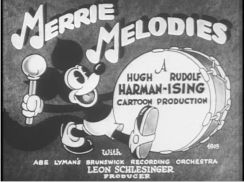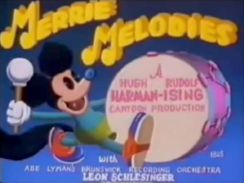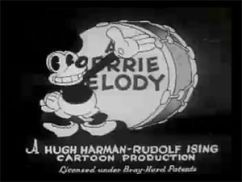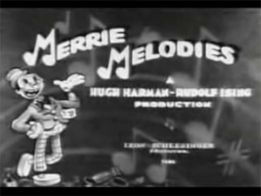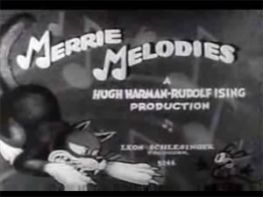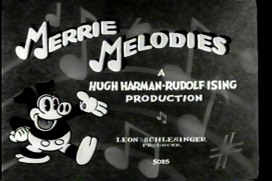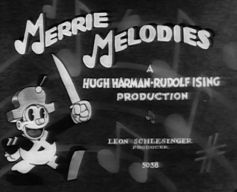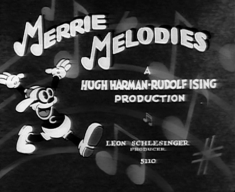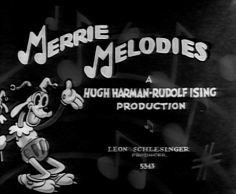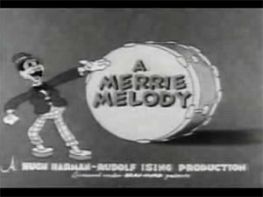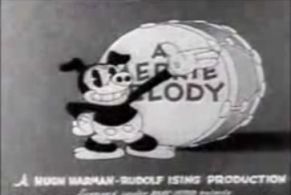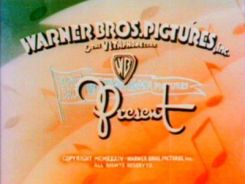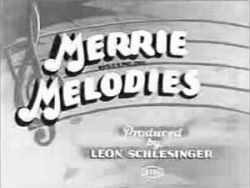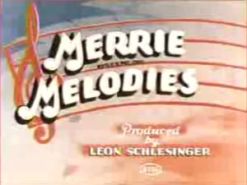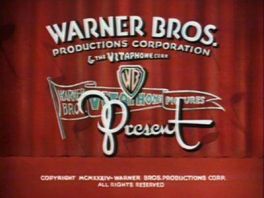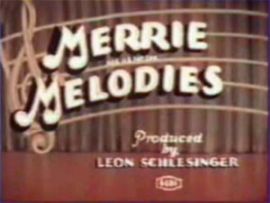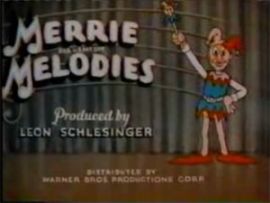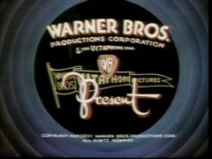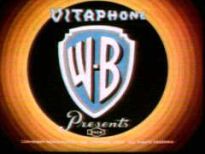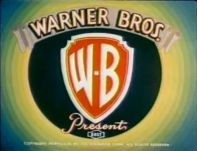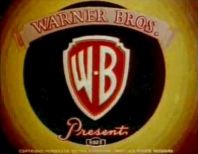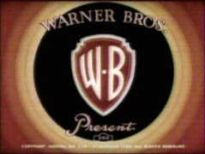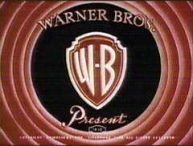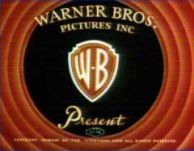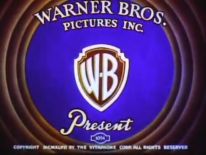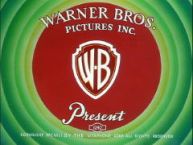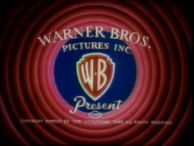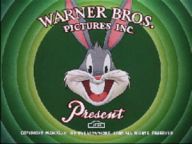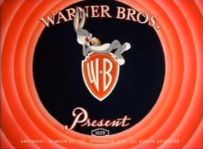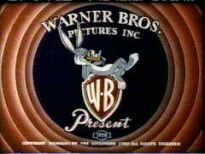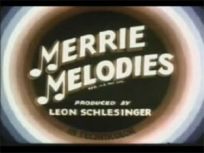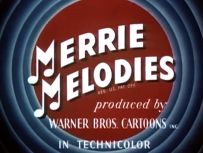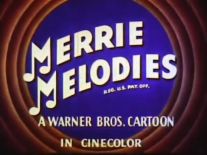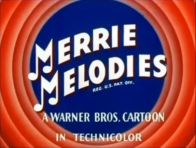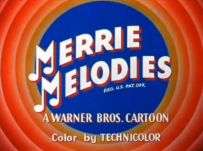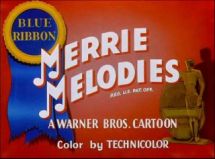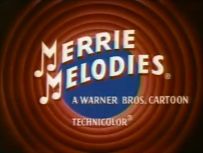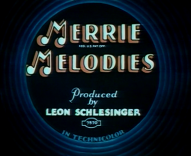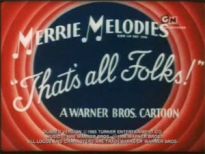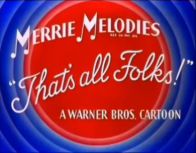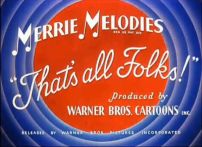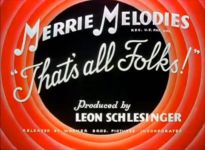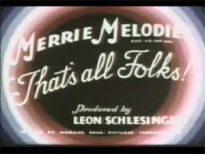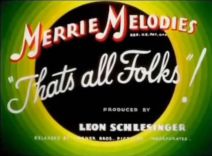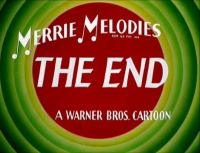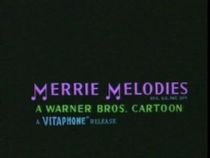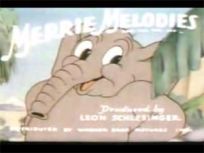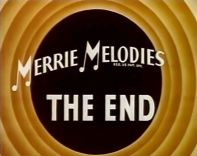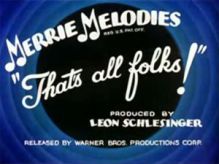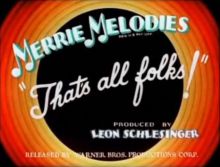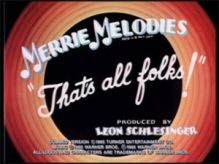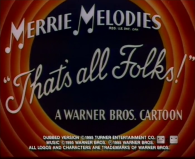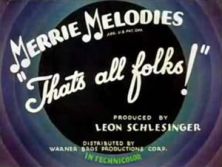Merrie Melodies IDs
Jump to navigation
Jump to search
Logo descriptions by
Videos by simone67053,CenaTv2 and Crili88
Background: Merrie Melodies is the name of a series of animated cartoons distributed by Warner Bros. Pictures between 1931 and 1969. The sister series to Warner's Looney Tunes, Merrie Melodies were originally one-shot musical cartoon shorts before gradually featuring recurring characters. By 1944, no distinctions existed between the two series. Originally produced by Harman-Ising Productions, Merrie Melodies were produced by Leon Schlesinger Productions from 1933 to 1944. Schlesinger sold his studio to Warner Bros. in 1944, and the newly renamed Warner Bros. Cartoons continued production until 1963. Merrie Melodies were outsourced to DePatie-Freleng Enterprises from 1964 to 1967, and Warner Bros. Animation (then-owned by Warner Bros.-Seven Arts) re-assumed production for the series' final two years. The logos for that era will be covered in the "Looney Tunes IDs" article. The name is a play on Walt Disney's Silly Symphonies, which is what the MM cartoons are based on.
1st Logo
(August-October 31, 1931)
Nickname: "Foxy Titles"
Studio Logo: On a gray (or black) background, the words "WARNER BROS. PICTURES, INC." are shown, and below that, "& THE VITAPHONE CORP." is shown in a much smaller font, with "VITAPHONE" using "electric" style letters. Below that is a very small WB shield, and in script, "Present". Behind it there is the drawing of a flag, "waving" so it looks like it is in 3 sections. On the first one, "WARNER BROS." Appears, followed by the electric-letter "VITAPHONE" logo and on section 3, "PICTURES". Below that is the copyright information.
Series Title: Against a gray background, the words "MERRIE MELODIES" in white are seen at the top of the screen, with the M's made out to look like musical eighth notes. Foxy is banging on a white drum (mounted on his chest as if he were playing it in a marching band), which reads (in black text) "A HUGH HARMAN-RUDOLF ISING CARTOON PRODUCTION" and below that, "With ABE LYMAN'S BRUNSWICK RECORDING ORCHESTRA" and "LEON SCHLESINGER, PRODUCER". The cartoon's production number is seen to the right of the drum.
Closing Logo: Against a gray (or black) background, Foxy stands in front of his marching-band drum reading "A MERRIE MELODY" (in plain black text) and says "So long, Folks!" or "That's all, Folks!" Below it, in white, are the words "A HUGH HARMAN-RUDOLF ISING CARTOON PRODUCTION" and below that, in italic script, is "Licensed under Bray-Hurd Patents".
Videos by simone67053,CenaTv2 and Crili88
Background: Merrie Melodies is the name of a series of animated cartoons distributed by Warner Bros. Pictures between 1931 and 1969. The sister series to Warner's Looney Tunes, Merrie Melodies were originally one-shot musical cartoon shorts before gradually featuring recurring characters. By 1944, no distinctions existed between the two series. Originally produced by Harman-Ising Productions, Merrie Melodies were produced by Leon Schlesinger Productions from 1933 to 1944. Schlesinger sold his studio to Warner Bros. in 1944, and the newly renamed Warner Bros. Cartoons continued production until 1963. Merrie Melodies were outsourced to DePatie-Freleng Enterprises from 1964 to 1967, and Warner Bros. Animation (then-owned by Warner Bros.-Seven Arts) re-assumed production for the series' final two years. The logos for that era will be covered in the "Looney Tunes IDs" article. The name is a play on Walt Disney's Silly Symphonies, which is what the MM cartoons are based on.
1st Logo
(August-October 31, 1931)
Nickname: "Foxy Titles"
Studio Logo: On a gray (or black) background, the words "WARNER BROS. PICTURES, INC." are shown, and below that, "& THE VITAPHONE CORP." is shown in a much smaller font, with "VITAPHONE" using "electric" style letters. Below that is a very small WB shield, and in script, "Present". Behind it there is the drawing of a flag, "waving" so it looks like it is in 3 sections. On the first one, "WARNER BROS." Appears, followed by the electric-letter "VITAPHONE" logo and on section 3, "PICTURES". Below that is the copyright information.
Series Title: Against a gray background, the words "MERRIE MELODIES" in white are seen at the top of the screen, with the M's made out to look like musical eighth notes. Foxy is banging on a white drum (mounted on his chest as if he were playing it in a marching band), which reads (in black text) "A HUGH HARMAN-RUDOLF ISING CARTOON PRODUCTION" and below that, "With ABE LYMAN'S BRUNSWICK RECORDING ORCHESTRA" and "LEON SCHLESINGER, PRODUCER". The cartoon's production number is seen to the right of the drum.
Closing Logo: Against a gray (or black) background, Foxy stands in front of his marching-band drum reading "A MERRIE MELODY" (in plain black text) and says "So long, Folks!" or "That's all, Folks!" Below it, in white, are the words "A HUGH HARMAN-RUDOLF ISING CARTOON PRODUCTION" and below that, in italic script, is "Licensed under Bray-Hurd Patents".
Variant: In the mid-1990s, Turner had two cartoons with this logo redrawn-colorized (Smile, Darn Ya, Smile and One More Time); but unlike when Warner had 79 black-and-white Looney Tunes colorized in the late 1960s, these two redrawns preserve their original logos, but colorized like the rest of the cartoons as well.
FX/SFX: None, except for the closing title.
Music/Sounds: "Get Happy" by Harold Arlen and Ted Koehler.
Availability: Extremely rare. This logo was only used on the first three Merrie Melodies. Two of them are spotted on the Looney Tunes Golden Collection DVD sets, and one on another unknown set.
Editors' Note:A pretty basic but good start for the Merrie Melodies series.
2nd Logo
(November 28, 1931-August 26, 1933)
Nicknames: "Piggy Titles", "Various Cartoon Character Titles"
Studio Logo: Same as the previous logo.
Series Title: On a BG of blurry musical notes and a staff, we see the Merrie Melodies logo at the top of the screen, along with the usual Hugh Harman-Rudolf Ising credit. We see Piggy (or another cartoon-specific one-shot character) on the left. The following text is also different: below the Hugh Harman-Rudolf Ising producer credits, we see the text below which now reads "LEON SCHLESINGER, PRODUCER" and sometimes, below that, "WITH GUS ARNHEIM'S BRUNSWICK RECORDING ORCHESTRA", separated by a musical eighth note.
Closing Logo: Same as logo 1, except for Piggy (or a cartoon-specific one-shot character) in place of Foxy. Also different, later in this logo's run: the words "Licensed under Bray-Hurd Patents" are replaced by "Distributed by Warner Bros. Pictures, Inc." (the former words were also seen below this new block of text on a few cartoons from this season). The words "CARTOON" is removed.
FX/SFX: Same as logo 1.
Music/Sounds: Same as logo 1. It is re-arranged at least once during the logo's run.
Availability: Rare; a handful of cartoons with this logo can be found on the Looney Tunes Golden Collection Vol. 6 DVD release.
Editors' Note: Same as logo 1.
3rd Logo
(September 30, 1933-June 30, 1934)
Nicknames: "B&W Titles", "Cinecolor/Technicolor Titles"
4th Logo
(September 8, 1934-November 20, 1935)
Nickname: "The Curtains"
Studio Logo: Similar to the last logo, but it is now on a red (later green) closed curtain background. The "WARNER BROS. PICTURES" line is shortened to only "WARNER BROS." With "PRODUCTIONS CORPORATION" underneath it, then the "& The Vitaphone Corporation" line
Series Title: Same as the last logo, except on a red (later green) closed curtain BG.
Closing Logo: Same as the previous, except we now see a jester in place of any given one-shot character against the closed curtain BG, announcing the usual "So long, folks!" or "That's all, Folks!" cadence. The text "WARNER BROS. PICTURES, INC." in the "Distributed by" field is changed to "WARNER BROS. PRODUCTIONS CORP."
FX/SFX: Same as the previous logo.
Music/Sounds: Same as the previous logo.
Availability: Rare, though it can be seen restored on the Looney Tunes Golden Collection DVDs. As of August 1, 2016 on Boomerang, some cartoons from this era have aired, nearly 10 years since this logo was last seen on American television.
Editors' Note: Same as the previous logo.
5th Logo
Nicknames: "The Merrie Melodies Bullseye", "The Merrie Melodies Concentric Circles"
Studio Logo: At the top of the screen, curved, the word "VITAPHONE" appears in the same electric letter font used previously, and on the very bottom is the word "Presents" in script, followed by the copyright info. The background is the famous "bullseye". And the WB shield's most famous role is now cemented: it zooms in from a long distance in the center of the screen to a huge size.
Series Title: In the middle of the "bullseye" and on the same background, "MERRIE MELODIES" again appears in its curved, musical note font. It was changed in 1937 to look more square-cut, and by late 1940 was now in its famed distinctive font. Below it appears "PRODUCED BY LEON SCHLESINGER." In 1944, this was changed to "PRODUCED BY WARNER BROS. CARTOONS, INC." and then "A WARNER BROS. CARTOON." All cartoons from this era are in color, and thus would bear the additional legend "IN TECHNICOLOR" (appearing first inside of the rings varying color, size, and font from 1936-43 and then as a separate legend from 1944-48), "IN CINECOLOR" (some 1947-49 cartoons only), "COLOR BY TECHNICOLOR" (1948-56), or "TECHNICOLOR" (1956-64).
Closing Logo: Starts with the "That's all Folks!" script being written out (or just "THE END" in plain letters, which were used on reissued prints from 1952-53), and then "MERRIE MELODIES" appearing at the top, curved as in the 3rd logo (and later refined). Near the bottom, either the Leon Schlesinger (or Warner Bros. Cartoons) text/Distributed (or Released) by WB Productions Corp. combo (1936-44) or "A WARNER BROS. CARTOON" (1944-64) was used. From 1960-64, the titles bore the additional legend: "A VITAPHONE RELEASE". The background was the circles/bullseye used in the studio logo. The colors of the backdrop vary by year, but a list of the colors would be too long to put here.
Blue Ribbon Reissues: The Blue Ribbon program began in late 1943 with about 13 classic Merrie Melodies being recycled each release season for another go-round. These reissues featured revised title cards that cut out the original production numbers and screen credits. The Blue Ribbon series logo consisted of a red background with a blue ribbon on the left (hence the name) and the Grand Shorts award on the right. In the middle of the screen was the 1940-style Merrie Melodies logo, and below that appeared either "produced by LEON SCHLESINGER" (1943-44) or "A WARNER BROS. CARTOON" (1945-61) as well as the following additional legends: "IN TECHNICOLOR" (1943-49), "COLOR BY TECHNICOLOR" (1949-58), "PRINT BY TECHNICOLOR" (seen on 1955-58 reprints of Cinecolor issues) or "TECHNICOLOR" (1958-61). It would then fade into either the title of the cartoon (1943-57) replete with MPPDA/MPAA and Cartoonists union bugs below, or cut to the original screen credits (1957-61). Early reissues had the cartoon title fade-in on a dark background.
Variants: There were many variants of this logo, and here are some of them:
FX/SFX: The "zooming shield".
Music/Sounds: "I Think You're Ducky" from January-September 1936. Starting in late 1936, the music changed to the famous "Merrily We Roll Along", arranged by Carl Stalling, first heard during Eddie Cantor's scenes in the 1935 short "Billboard Frolics". In mid 1937, the WB shield has its sound effect--the famous "twanging" noise created by Treg Brown. In 1945, this theme (the opening version) was shortened somewhat. The long version of the opening theme was used up through the Blue Ribbon reissues of the pre-1948 cartoons. Oddly enough, however, one Merrie Melodies short, "Horton Hatches the Egg" (originally from 1942) did air in syndication (at one time) with the Looney Tunes sig "The Merry-Go-Round Broke Down" playing at the end, which is standard for Looney Tunes re-issued as Merrie Melodies. Also, the Merrie Melodies short, "Tweety and the Beanstalk", released in 1955, features the Looney Tunes sig "The Merry-Go-Round Broke Down" playing at the beginning and the end.
Closing Logo Music: Until 1937, the last piece of short's score played over in the end title. Starting in mid-1937, an abridged version of the famous "Merrily We Roll Along" theme (first used as the main title music beginning with the short "Boulevardier from the Bronx" released Oct. 10, 1936) was heard in the end title.
Music/Sound Variants: Many. Here's a listing:
Availability: It appears on most of the Merrie Melodies being rerun on Boomerang (Cartoon Network generally doesn't show them currently. It was used on over five hundred Merrie Melodies shorts, including famous ones like "What's Opera, Doc?" and "One Froggy Evening". They can be found on the Looney Tunes Golden Collection and Looney Tunes Super Stars DVD sets, and the Looney Tunes Platinum Collection Blu-Ray sets. The "I Wanna Play House" variant is ultra rare. The "THE END" reissue closing variant is not easy to find, as many cartoons that used it have had a "That's all, Folks!" closing plastered over during the 1990s; it is intact on the LTGC release of The Bashful Buzzard.
Editors' Note: This is a very famous and well-liked logo, with all the familiar elements in by its' second year of use (the concentric circles background, the zooming WB shield, the use of "Merrily We Roll Along" as the theme music and the "That's all, Folks!" closing text). It's pretty neat to see how the logo has evolved over the years, especially in the 1936-1941 era.
FX/SFX: None, except for the closing title.
Music/Sounds: "Get Happy" by Harold Arlen and Ted Koehler.
Availability: Extremely rare. This logo was only used on the first three Merrie Melodies. Two of them are spotted on the Looney Tunes Golden Collection DVD sets, and one on another unknown set.
Editors' Note:A pretty basic but good start for the Merrie Melodies series.
2nd Logo
(November 28, 1931-August 26, 1933)
Nicknames: "Piggy Titles", "Various Cartoon Character Titles"
Studio Logo: Same as the previous logo.
Series Title: On a BG of blurry musical notes and a staff, we see the Merrie Melodies logo at the top of the screen, along with the usual Hugh Harman-Rudolf Ising credit. We see Piggy (or another cartoon-specific one-shot character) on the left. The following text is also different: below the Hugh Harman-Rudolf Ising producer credits, we see the text below which now reads "LEON SCHLESINGER, PRODUCER" and sometimes, below that, "WITH GUS ARNHEIM'S BRUNSWICK RECORDING ORCHESTRA", separated by a musical eighth note.
Closing Logo: Same as logo 1, except for Piggy (or a cartoon-specific one-shot character) in place of Foxy. Also different, later in this logo's run: the words "Licensed under Bray-Hurd Patents" are replaced by "Distributed by Warner Bros. Pictures, Inc." (the former words were also seen below this new block of text on a few cartoons from this season). The words "CARTOON" is removed.
FX/SFX: Same as logo 1.
Music/Sounds: Same as logo 1. It is re-arranged at least once during the logo's run.
Availability: Rare; a handful of cartoons with this logo can be found on the Looney Tunes Golden Collection Vol. 6 DVD release.
Editors' Note: Same as logo 1.
3rd Logo
(September 30, 1933-June 30, 1934)
Nicknames: "B&W Titles", "Cinecolor/Technicolor Titles"
Studio Logo: Again, same as WB logos 1 and 2, though it may be shown against a background of musical notes. However, from 1934-1935, the "WARNER BROS. PICTURES" line is shortened to only "WARNER BROS." with "PRODUCTIONS CORPORATION" underneath it, then the "& THE VITAPHONE CORPORATION" line.
Series Title: On a background of musical notes, in the middle of the screen (with a drawing of the C diatonic musical scale), in a curved musical note font, are the words "MERRIE MELODIES". Below that, to the right, are the words "PRODUCED BY LEON SCHLESINGER" and the production #.
Closing Logo: On a stage, we see a one-shot character featured in the cartoon just ending announcing "That's all, Folks!" (or "So long, Folks!"). To its left are the words "MERRIE MELODIES" in its musical-note font, and "PRODUCED BY LEON SCHLESINGER". Below all that are the words "DISTRIBUTED BY WARNER BROS. PICTURES, INC."
FX/SFX: Same as logo 1.
Music/Sounds: "I Think You're Ducky" composed by Gerald Marks, Sidney Clare, and Charles Tobias.
Availability: Extremely rare; however, this can be found on some of the Looney Tunes Golden Collection DVD sets.
Editors' Note: Same as logo 1. It still has very little in common with the more familiar 5th logo...
Series Title: On a background of musical notes, in the middle of the screen (with a drawing of the C diatonic musical scale), in a curved musical note font, are the words "MERRIE MELODIES". Below that, to the right, are the words "PRODUCED BY LEON SCHLESINGER" and the production #.
Closing Logo: On a stage, we see a one-shot character featured in the cartoon just ending announcing "That's all, Folks!" (or "So long, Folks!"). To its left are the words "MERRIE MELODIES" in its musical-note font, and "PRODUCED BY LEON SCHLESINGER". Below all that are the words "DISTRIBUTED BY WARNER BROS. PICTURES, INC."
FX/SFX: Same as logo 1.
Music/Sounds: "I Think You're Ducky" composed by Gerald Marks, Sidney Clare, and Charles Tobias.
Availability: Extremely rare; however, this can be found on some of the Looney Tunes Golden Collection DVD sets.
Editors' Note: Same as logo 1. It still has very little in common with the more familiar 5th logo...
4th Logo
(September 8, 1934-November 20, 1935)
<embed allowfullscreen="true" height="250" src="http://wikifoundrytools.com/wiki/closinglogos/widget/youtubevideo/004ae2ee500c7a3ee8aee1f3a9104b0b5b32f5e1" type="application/x-shockwave-flash" width="303" wmode="transparent"/>
Nickname: "The Curtains"
Studio Logo: Similar to the last logo, but it is now on a red (later green) closed curtain background. The "WARNER BROS. PICTURES" line is shortened to only "WARNER BROS." With "PRODUCTIONS CORPORATION" underneath it, then the "& The Vitaphone Corporation" line
Series Title: Same as the last logo, except on a red (later green) closed curtain BG.
Closing Logo: Same as the previous, except we now see a jester in place of any given one-shot character against the closed curtain BG, announcing the usual "So long, folks!" or "That's all, Folks!" cadence. The text "WARNER BROS. PICTURES, INC." in the "Distributed by" field is changed to "WARNER BROS. PRODUCTIONS CORP."
FX/SFX: Same as the previous logo.
Music/Sounds: Same as the previous logo.
Availability: Rare, though it can be seen restored on the Looney Tunes Golden Collection DVDs. As of August 1, 2016 on Boomerang, some cartoons from this era have aired, nearly 10 years since this logo was last seen on American television.
Editors' Note: Same as the previous logo.
5th Logo
(January 11, 1936-June 27, 1964)
<embed allowfullscreen="true" height="221" src="http://wikifoundrytools.com/wiki/closinglogos/widget/youtubevideo/d1e7fa094396428802eeeef71e050be542fff2b0" type="application/x-shockwave-flash" width="266" wmode="transparent"/><embed allowfullscreen="true" height="222" src="http://wikifoundrytools.com/wiki/closinglogos/widget/youtubevideo/c98bca0c8aa8cd48eeb6875eca1c618104fca9e1" type="application/x-shockwave-flash" width="271" wmode="transparent"/>
Nicknames: "The Merrie Melodies Bullseye", "The Merrie Melodies Concentric Circles"
Studio Logo: At the top of the screen, curved, the word "VITAPHONE" appears in the same electric letter font used previously, and on the very bottom is the word "Presents" in script, followed by the copyright info. The background is the famous "bullseye". And the WB shield's most famous role is now cemented: it zooms in from a long distance in the center of the screen to a huge size.
Series Title: In the middle of the "bullseye" and on the same background, "MERRIE MELODIES" again appears in its curved, musical note font. It was changed in 1937 to look more square-cut, and by late 1940 was now in its famed distinctive font. Below it appears "PRODUCED BY LEON SCHLESINGER." In 1944, this was changed to "PRODUCED BY WARNER BROS. CARTOONS, INC." and then "A WARNER BROS. CARTOON." All cartoons from this era are in color, and thus would bear the additional legend "IN TECHNICOLOR" (appearing first inside of the rings varying color, size, and font from 1936-43 and then as a separate legend from 1944-48), "IN CINECOLOR" (some 1947-49 cartoons only), "COLOR BY TECHNICOLOR" (1948-56), or "TECHNICOLOR" (1956-64).
Closing Logo: Starts with the "That's all Folks!" script being written out (or just "THE END" in plain letters, which were used on reissued prints from 1952-53), and then "MERRIE MELODIES" appearing at the top, curved as in the 3rd logo (and later refined). Near the bottom, either the Leon Schlesinger (or Warner Bros. Cartoons) text/Distributed (or Released) by WB Productions Corp. combo (1936-44) or "A WARNER BROS. CARTOON" (1944-64) was used. From 1960-64, the titles bore the additional legend: "A VITAPHONE RELEASE". The background was the circles/bullseye used in the studio logo. The colors of the backdrop vary by year, but a list of the colors would be too long to put here.
Blue Ribbon Reissues: The Blue Ribbon program began in late 1943 with about 13 classic Merrie Melodies being recycled each release season for another go-round. These reissues featured revised title cards that cut out the original production numbers and screen credits. The Blue Ribbon series logo consisted of a red background with a blue ribbon on the left (hence the name) and the Grand Shorts award on the right. In the middle of the screen was the 1940-style Merrie Melodies logo, and below that appeared either "produced by LEON SCHLESINGER" (1943-44) or "A WARNER BROS. CARTOON" (1945-61) as well as the following additional legends: "IN TECHNICOLOR" (1943-49), "COLOR BY TECHNICOLOR" (1949-58), "PRINT BY TECHNICOLOR" (seen on 1955-58 reprints of Cinecolor issues) or "TECHNICOLOR" (1958-61). It would then fade into either the title of the cartoon (1943-57) replete with MPPDA/MPAA and Cartoonists union bugs below, or cut to the original screen credits (1957-61). Early reissues had the cartoon title fade-in on a dark background.
Variants: There were many variants of this logo, and here are some of them:
- For the very first cartoons using the "bullseye" (such as I Wanna Play House), a logo similar to MM logo #1 appears, but the "WARNER BROS. PICTURES" line is shortened to only "WARNER BROS." with "PRODUCTIONS CORPORATION" underneath it, then the "& the Vitaphone Corporation" line. Also, starting in 1939, "VITAPHONE" was changed to "WARNER BROS.," and "Presents" was changed to "Present". From 1944 on (after Leon Schlesinger's retirement from the studio), it bore the additional legend "PICTURES, INC.".
- Some older Merrie Melodies were re-released as part of the "Blue Ribbon" series, and lost their title cards as a result. The re-releases of the pre-1941 cartoons kept whatever music variation it had at the end (except for the 1935 cartoons that originally ended with the jester's sign-off), and any cartoon re-released before 1945 would retain its original end title as well. Most of the pre-1948 cartoons had the long version of the "Merrily" opening theme. The re-releases of the post-1948 cartoons had the short version at the open and retained their full credits. Oddly enough, however, one pre-1948 Merrie Melody from 1940 (which was reissued in 1953-54), "Mighty Hunters", retained its original screen credits.
- The most famous one of these, with Bugs Bunny relaxing on top of the shield as it zooms in. He chomps on his carrot for a few seconds, looks "angry" at the "camera", and then pulls down the next logo, the Looney Tunes / Merrie Melodies logo, like a window shade. This was only used on Bugs Bunny cartoons. It was first used in "The Heckling Hare".
- The shield fades into Bugs Bunny's head. This was used only on Bugs Bunny cartoons.
- On "The Old Grey Hare" (1944), an ending gag involving a stick of dynamite had a still "That's All, Folks!" title card fading up as the fuse was heard sizzling, and then the logo shakes violently to the sound of the dynamite exploding. When reran on Cartoon Network / Boomerang, It was replaced with the regular "That's All, Folks!" title. The Dynamite Exploding is still sound but the title does not shake.
- On "The Major Lied 'Til Dawn" (1938), it ends with a zoom-up of the elephant with him saying "That's all, folks!". The usual text fades in in white, with a much quicker and higher-pitched version of the end theme playing over it.
- A still variation of the end title as seen on the 1953-54 season re-releases of the pre-1948 cartoons (with the early 1300 series production #s) had the phrase "THE END" (in the Mixolydian font) in place of the "That's all Folks!" script with the original closing music from whatever short's end title was originally there. This also happened on United Artists prints of these films as an attempt to remove any reference to Warner Bros, i.e. with an orange bullseye and red center.
- Another still variation of the end title, this time with the usual "That's all Folks!" script, was spotted on the 1954-55 season re-release of the last 2-strip Technicolor-processed MM short, "The Cat Came Back" (Blue Ribbon #1361, originally released in 1936).
- On the 1961 short "Nelly's Folly," this cartoon had a different end card, in which after the cartoon faded out with the title "THE END", it fades up to the Merrie Melodies text in purple, with "A WARNER BROS. CARTOON" and "A VITAPHONE RELEASE" underneath it, on a black background. There was no music used here.
- In 1995, Turner Entertainment created the infamous "dubbed version" re-releases of the pre-1948 LT and MM cartoons, which share the same end card ("Porky in a Drum" or the "Bullseye Circles" in either orange (1937-1938) or red (1947-1948) rings) with copyright text chyroned in below. The variant with the 1937-1938 closing also freeze-frames before the "RELEASED BY WARNER BROS. PRODUCTION CORP." byline appears so the "dubbed version" copyright text can take its' place below. In many cases, the original closing music from the cartoon ending is utilized, but once in a while, the incorrect closing music may be heard. Several of these are still seen on TV and the "Looney Tunes Golden Collection" DVDs.
FX/SFX: The "zooming shield".
Music/Sounds: "I Think You're Ducky" from January-September 1936. Starting in late 1936, the music changed to the famous "Merrily We Roll Along", arranged by Carl Stalling, first heard during Eddie Cantor's scenes in the 1935 short "Billboard Frolics". In mid 1937, the WB shield has its sound effect--the famous "twanging" noise created by Treg Brown. In 1945, this theme (the opening version) was shortened somewhat. The long version of the opening theme was used up through the Blue Ribbon reissues of the pre-1948 cartoons. Oddly enough, however, one Merrie Melodies short, "Horton Hatches the Egg" (originally from 1942) did air in syndication (at one time) with the Looney Tunes sig "The Merry-Go-Round Broke Down" playing at the end, which is standard for Looney Tunes re-issued as Merrie Melodies. Also, the Merrie Melodies short, "Tweety and the Beanstalk", released in 1955, features the Looney Tunes sig "The Merry-Go-Round Broke Down" playing at the beginning and the end.
Closing Logo Music: Until 1937, the last piece of short's score played over in the end title. Starting in mid-1937, an abridged version of the famous "Merrily We Roll Along" theme (first used as the main title music beginning with the short "Boulevardier from the Bronx" released Oct. 10, 1936) was heard in the end title.
Music/Sound Variants: Many. Here's a listing:
- October 1936-November 1936: Fast-paced opening theme more dominated with woodwinds.
- November 1936-Janurary 1937: Similar to October 1936 theme, but has some of the more distinct traits in the theme now.
- March-early July 1937: Slower-paced version of above opening theme.
- Late July-early September 1937: Opening theme now begins with the aforementioned (yet famous) "twang" sound. The closing theme version also makes its debut, on Plenty of Money and You, which also begins with the "twang" sound.
- Late September 1937-early January 1938: Opening theme now has a largely woodwind-dominated arrangement, same went for the closing theme.
- Late January-July 1938: Opening theme sparsely modified, same closing theme version as late September 1937.
- August 1938-early January 1939: Opening theme now dominated by brass and strings. Closing theme is also adapted from the opening version beginning in November 1938.
- Late January 1939-early September 1940: Second most well-known version of "Merrily We Roll Along." Heavily modified, first "perfected" version of the opening theme. Same closing theme as November 1938 version.
- Late September 1940-March 1941: Opening theme modified somewhat, which sounds like a hybrid of the August 1938 and late January 1939 versions. Same closing theme as November 1938 version.
- April 1941-March 1945: Most well-known version of "Merrily We Roll Along". Heavily modified, more "brassy" opening and closing themes. The long version continued use through the Blue Ribbon reissues of cartoons originally released prior to December 1948.
- A slight variation of the end theme, with a livelier finish, was used on The Wacky Wabbit and Peck Up Your Troubles, as well as the Blue Ribbon version of Tick Tock Tuckered.
- May 1945-June 1955: Abridged opening theme, same closing theme as April 1941. Was still used for the Blue Ribbon reissues of cartoons originally released up to 1955.
- June 18, 1949: On the Blue Ribbon reissue of Horton Hatches the Egg, the 1946 arrangement of "The Merry-Go-Round Broke Down" played over the closing title.
- May 1955-July 1964: Heavily modified opening and closing themes, this time arranged by Milt Franklyn. Sparsely used for Blue Ribbon reissues.
- October 1956-July 1964: On Tweety and the Beanstalk, Blue Ribbon reissues of Looney Tunes shorts, and the end of Looney Tune short Boston Quackie, the 1946 or 1955 arrangement of "The Merry-Go-Round Broke Down" was used.
Availability: It appears on most of the Merrie Melodies being rerun on Boomerang (Cartoon Network generally doesn't show them currently. It was used on over five hundred Merrie Melodies shorts, including famous ones like "What's Opera, Doc?" and "One Froggy Evening". They can be found on the Looney Tunes Golden Collection and Looney Tunes Super Stars DVD sets, and the Looney Tunes Platinum Collection Blu-Ray sets. The "I Wanna Play House" variant is ultra rare. The "THE END" reissue closing variant is not easy to find, as many cartoons that used it have had a "That's all, Folks!" closing plastered over during the 1990s; it is intact on the LTGC release of The Bashful Buzzard.
Editors' Note: This is a very famous and well-liked logo, with all the familiar elements in by its' second year of use (the concentric circles background, the zooming WB shield, the use of "Merrily We Roll Along" as the theme music and the "That's all, Folks!" closing text). It's pretty neat to see how the logo has evolved over the years, especially in the 1936-1941 era.
<embed allowfullscreen="true" height="350" src="http://wikifoundrytools.com/wiki/closinglogos/widget/youtubevideo/aa7ed07643b603fd7d0d900c2656d99f84195285" type="application/x-shockwave-flash" width="425" wmode="transparent"/>
